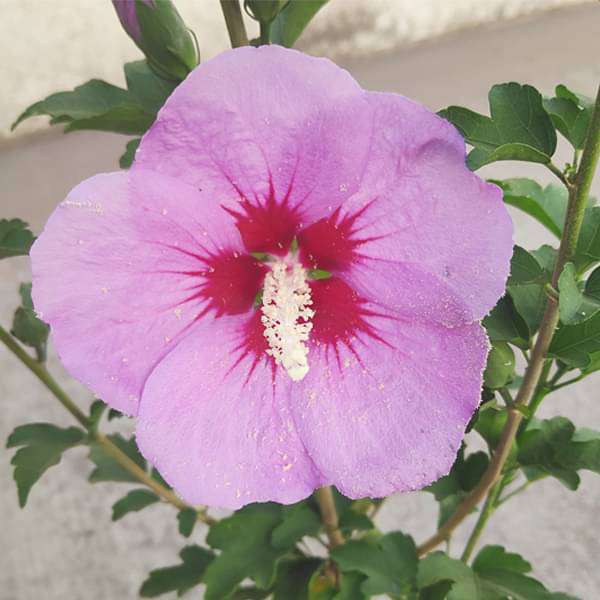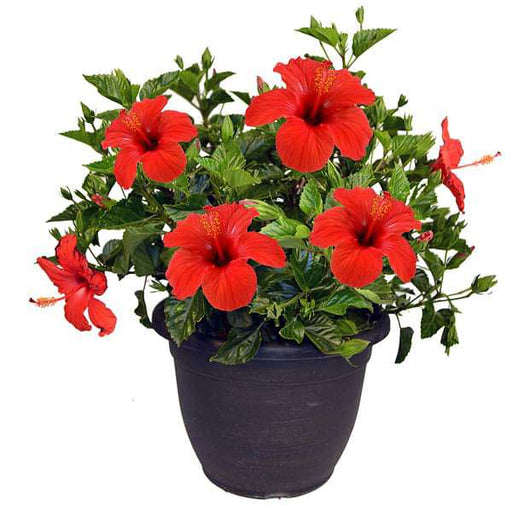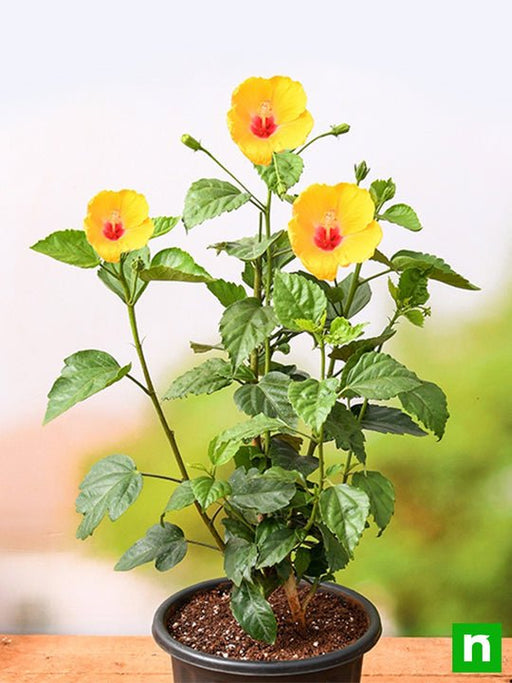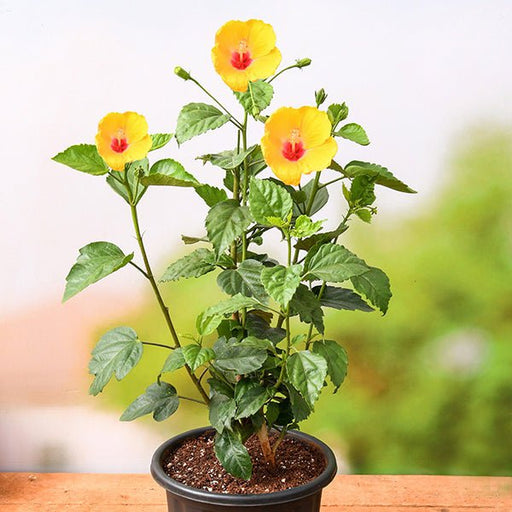
Hibiscus, Gudhal Flower (Purple) - Plant
(MRP Inclusive of all taxes)
- Shipping ₹79 for entire order
- Dispatch in 7 days
- Country of origin: India

(MRP Inclusive of all taxes)
 Save 25%
Save 25%
Hibiscus, Gudhal Flower (Red Double) - Plant The Hibiscus, also known as Gudhal Flower, is a stunning ornamental plant that boasts vibrant...
View full details
 Save 25%
Save 25%
Hibiscus, Gudhal Flower (Red) - Plant The Hibiscus, commonly known as Gudhal Flower, is a stunning tropical plant renowned for its vibrant red blo...
View full details Save 25%
Save 25%
Hibiscus, Gudhal Flower (Peach Double) - Plant The Hibiscus, also known as Gudhal Flower, is a stunning ornamental plant that showcases be...
View full details
 Save 25%
Save 25%
Hibiscus, Gudhal Flower (Pink) - Plant The Hibiscus, commonly known as Gudhal, is a stunning flowering plant that captivates with its vibrant pink...
View full details Save 25%
Save 25%
Hibiscus, Gudhal Flower (Yellow) - Plant The Hibiscus, commonly known as Gudhal, is a stunning flowering plant that captivates with its vibrant ye...
View full details Save 18%
Save 18%
Hibiscus, Gudhal Flower (Hybrid, Any Color) - Plant The Hibiscus, also known as Gudhal, is a stunning hybrid plant that brings vibrant col...
View full details
 Save 25%
Save 25%
Hibiscus, Gudhal Flower (Yellow Red) - Plant The Hibiscus, commonly known as Gudhal, is a stunning flowering plant that captivates with it...
View full details Save 15%
Save 15%
Pack of Vermicompost and Neem Cake for House Plants Transform your indoor garden with our premium Pack of Vermicompost and Neem Cake, spec...
View full details
Pack of Plant Growth and Flower Boosters Unlock the full potential of your garden with our Pack of Plant Growth and Flower Boosters! This ...
View full details Save 38%
Save 38%
Combo of Jeevamrut and Neem Raksha for Easy Growth and Protection of Houseplants Transform your indoor garden with our exclusive combo of ...
View full details Save 22%
Save 22%
Plant Nutrients Kit (Pack of 16) for a Healthy Garden Transform your garden into a lush paradise with our Plant Nutrients Kit, featuring 1...
View full details Save 16%
Save 16%
Combo of Top Plant Fertilizers Elevate your gardening game with our exclusive Combo of Top Plant Fertilizers, featuring two bags of premiu...
View full details Save 24%
Save 24%
Pack of 4 Additives to Make Soil Healthy and Nutrient Rich Transform your garden into a thriving ecosystem with our Pack of 4 Additives de...
View full details Save 30%
Save 30%
Transform your gardening experience with our premium Combo of Perlite and Vermiculite. This unique blend is designed to enhance soil aeration and ...
View full details Save 27%
Save 27%
Combo of 2 Vermicompost and Cocopeat - Enrich Your Soil Naturally! Transform your garden into a thriving ecosystem with our Combo of 2 Ver...
View full details
 Save 35%
Save 35%
Best 6 Plants for Perfect Indoor Garden Transform your living space into a lush oasis with our curated collection of the Best 6 Plants for a...
View full details
 Save up to 50%
Save up to 50%
Mini Succulent Garden Pack Transform your space with our Mini Succulent Garden Pack, featuring a delightful collection of 4 any variety beautiful s...
View full details
 Save 30%
Save 30%
5 Best Fragrant Plants Transform your garden or indoor space into a fragrant paradise with our curated selection of the 5 Best Fragrant Plants. Th...
View full details
 Save 24%
Save 24%
Set of 2 Bonsai Looking Grafted Adeniums Transform your indoor or outdoor space with our exquisite Set of 2 Bonsai Looking Grafted Adenium...
View full details Save 45%
Save 45%
Top 4 Die Hard Succulents Pack Transform your indoor or outdoor space with our Top 4 Die Hard Succulents Pack, featuring a curated selecti...
View full details
 Save 30%
Save 30%
5 Best Indoor Plants Pack Transform your living space into a lush oasis with our '5 Best Indoor Plants Pack.' This carefully curated collection fe...
View full details
 Save 25%
Save 25%
Set of 4 Evergreen Air Purifier Plant Pack Transform your indoor space into a lush, green oasis with our Set of 4 Evergreen Air Purifier Pla...
View full details| SrNo | Item Name | Qty |
|---|---|---|
| 1 | Hibiscus (Purple) Plant | 1 |
The stunning Hibiscus, also known as Gudhal Flower, is a tropical plant celebrated for its vibrant purple blooms. This perennial beauty not only enhances your garden but also attracts pollinators like bees and butterflies, making it a vital part of the ecosystem. With its lush foliage and striking flowers, the Hibiscus plant is a favorite among gardeners and nature enthusiasts alike.
What makes the purple Hibiscus special is its rich cultural significance and medicinal properties. Historically, it has been used in traditional medicine for its anti-inflammatory and antioxidant benefits. The plant thrives in warm climates, making it an excellent choice for gardens in temperate regions.
One of the standout features of the Hibiscus plant is its ability to bloom continuously throughout the growing season, providing a stunning display of color. Its flowers can reach up to 6 inches in diameter, creating a breathtaking focal point in any landscape.
If you think caring for a Hibiscus is as easy as watering a cactus, think again! These beauties thrive on attention and a sprinkle of love. They demand well-drained soil, plenty of sunlight, and a regular feeding schedule. Treat them right, and they’ll reward you with vibrant blooms that could make even the sun jealous. Just remember, neglect them, and they might sulk like a teenager denied their phone!
The Purple Hibiscus isn’t just a pretty face; it’s a powerhouse of health benefits! Packed with antioxidants, it can help lower blood pressure and improve digestion. Plus, it’s a natural mood booster. So, if you’re feeling down, just gaze at those stunning purple petals, and let the good vibes flow. Who knew a flower could be your therapist?
Sip, sip, hooray! Hibiscus tea is the refreshing drink you didn’t know you needed. With its tart flavor and vibrant color, it’s like a party in your cup. Not only does it taste fabulous, but it also comes with a side of health benefits, including improved heart health and a metabolism boost. So, brew a cup, kick back, and let the floral magic work its wonders.
Planting a Hibiscus is like setting the stage for a floral Broadway show. Choose a sunny spot, prepare the soil, and give it room to grow. These plants love to spread their roots, so don’t crowd them! With the right care, your Hibiscus will take center stage in your garden, dazzling everyone with its stunning blooms.
The world of Hibiscus is as diverse as a box of chocolates. From the classic red to the enchanting purple, each variety has its own charm. Some are show-stoppers, while others are subtle beauties. Explore the different types, and you’ll find the perfect Hibiscus to match your garden’s personality. After all, variety is the spice of life!
Beware, the Hibiscus has its fair share of uninvited guests! Aphids, spider mites, and whiteflies are just a few of the pests that might crash your floral party. But fear not! With a little vigilance and some natural pest control methods, you can keep your Hibiscus safe and sound. After all, no one likes a party crasher!
Feeding your Hibiscus is like giving it a gourmet meal. A balanced fertilizer will keep those blooms coming and the leaves lush. Opt for a slow-release formula during the growing season, and watch your plant thrive. Just don’t overdo it; too much fertilizer can lead to a case of the “too much of a good thing” syndrome!
Pruning your Hibiscus is like giving it a stylish haircut. It may look a bit bare at first, but trust the process! Regular pruning encourages new growth and helps maintain a beautiful shape. Just remember to wield your shears with care; you want to enhance your plant’s beauty, not turn it into a botanical disaster!
If you want to add a pop of color to your landscape, the Hibiscus is your go-to plant. These vibrant flowers can transform any garden into a tropical paradise. Use them as focal points, borders, or even in containers. With their bold hues and lush foliage, they’ll have your neighbors green with envy!
The Hibiscus is a pollinator’s paradise! Bees, butterflies, and hummingbirds can’t resist the allure of its nectar-rich blooms. By planting Hibiscus in your garden, you’re not just beautifying your space; you’re also creating a haven for these essential creatures. So, let your garden be the buzzing hotspot of the neighborhood!
Who says Hibiscus can’t be an indoor diva? With the right care, these tropical beauties can thrive indoors, bringing a splash of color to your living space. Just ensure they get enough sunlight and humidity, and they’ll reward you with stunning blooms. Your home will feel like a tropical getaway, minus the plane ticket!
The Hibiscus, or Gudhal Flower, is a stunning purple plant that’s like nature’s own confetti. With its large, vibrant blooms, it’s a showstopper in any garden. This tropical beauty not only adds color but also attracts pollinators, making it a party for bees and butterflies. Who wouldn’t want a floral fiesta in their backyard
Caring for your Hibiscus is like nurturing a diva. It loves full sun, well-drained soil, and regular watering—just not a soggy bottom! Fertilize every few weeks during the growing season, and don’t forget to prune for that perfect shape. With a little TLC, your plant will bloom like it’s auditioning for a floral magazine cover.
Get ready for a floral extravaganza! The Hibiscus typically blooms from late spring to early fall, showering your garden with purple petals. Each bloom lasts just a day, but don’t fret—new ones pop up like they’re in a race. It’s a daily surprise party, and you’re invited to enjoy the show!
Absolutely! Your Hibiscus can be a fabulous indoor diva, but it craves bright light like a sunbather on a tropical beach. Ensure it has enough space to spread its leaves and blooms. Just remember, it’s a bit of a drama queen—keep the humidity up and water regularly, and it’ll reward you with stunning flowers.
Good news for pet parents! The Hibiscus plant is generally non-toxic to cats and dogs. However, just because it’s safe doesn’t mean your furry friends won’t treat it like a chew toy. Keep an eye on them; after all, we wouldn’t want your pet to mistake it for a salad!
Watering your Hibiscus is like giving it a refreshing drink after a workout. Aim for once a week, but check the soil first—if it’s dry an inch down, it’s time to hydrate! Just avoid drowning it; this diva prefers a well-drained stage to show off its blooms.
Your Hibiscus is a soil snob! It thrives in well-draining, loamy soil enriched with organic matter. Think of it as a five-star hotel for roots. A pH of 6.0 to 7.0 is ideal, so mix in some compost or peat moss to keep it happy. A happy plant equals a blooming superstar!
Yes, you can! Propagating your Hibiscus is like creating mini versions of your floral superstar. Take cuttings in spring or summer, dip them in rooting hormone, and plant them in moist soil. With a little patience and care, you’ll have new plants ready to join the garden party in no time!
Your Hibiscus might attract some uninvited guests like aphids, spider mites, and whiteflies. Think of them as the party crashers of the plant world. Keep an eye out and treat them with insecticidal soap or neem oil. A little vigilance will keep your floral bash pest-free and fabulous!
Hibiscus is a tropical star, so winter can be a bit harsh. If you live in a cooler climate, bring it indoors or provide protection with mulch. It’s like giving your plant a cozy blanket for the winter. With the right care, it’ll bounce back in spring, ready to dazzle again!
Growing Hibiscus is like having a personal cheerleader in your garden! It adds vibrant color, attracts pollinators, and can even be used for herbal teas. Plus, it’s a natural air purifier. So, not only does it look good, but it also helps you breathe easier. Talk about a multitasking plant!
Absolutely! The Hibiscus is a landscaping superstar, perfect for borders, hedges, or as a focal point. Its bold purple blooms create a stunning contrast against green foliage. Plus, it’s low-maintenance, so you can spend more time enjoying your garden and less time fussing over it. Who doesn’t love a low-effort beauty